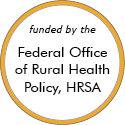Rural Project Examples: Community engagement and volunteerism
Promising Examples
Communities that Care Coalition
Updated/reviewed April 2023
- Need: To improve the health, well-being, and equity of young people in the rural area of Massachusetts's Franklin County and North Quabbin, and to reduce youth drug and alcohol use.
- Intervention: A community-based prevention coalition was formed to improve youth health, well-being, and equity and reduce youth drug and alcohol use use. The coalition brings together stakeholders from across the community and uses the Communities That Care evidence-based community planning system.
- Results: CTC has seen significant reductions in substance abuse among local youth in the 30 rural towns they serve.
Maryland Faith Health Network
Updated/reviewed December 2022
- Need: To coordinate formal and informal community-based caregivers for optimal patient experience.
- Intervention: The Maryland Faith Health Network unites places of worship and healthcare systems in Maryland. This program aims to decrease the amount of potentially avoidable hospitalizations, improve a patient's overall wellness, and cut down on the cost of medical services.
- Results: This model is currently running in 3 hospitals that serve both rural and urban residents in central Maryland. So far, 1,300 congregants from 70 congregations representing Christian, Jewish, and Muslim faiths have enrolled in the Network.
Other Project Examples
Community Collaboration Adaptation of COPEWELL with Rural Texas Libraries
Added March 2024
- Need: To help rural communities in Texas better prepare for disasters and emergency events.
- Intervention: A year-long pilot project used focus groups, a survey, and exit interviews to research a collaboration with librarians and diverse stakeholders to discuss a community's strengths and opportunities for resiliency planning.
- Results: Community stakeholders in Pottsboro and Gladewater collaborated to identify challenges to rural disaster preparedness like aging infrastructure and lack of communication with residents. They began the process to address these challenges through local resiliency planning and future programming.
Healthy Communities Coalition of Lyon and Storey Counties (HCC)
Updated/reviewed January 2024
- Need: To increase access to healthy foods in two rural Nevada counties.
- Intervention: HCC and the Rural Health and Nutrition Initiative (RHNI) run food pantries, assist with community and school gardens, and have a farmers market during the summer.
- Results: The three food pantries together serve about 3,600 people and distribute over 100,000 pounds of food each month.
Rural Aging Action Network
Updated/reviewed January 2024
- Need: To connect underserved and isolated older adults in rural Minnesota, Montana, North Dakota, and South Dakota to services and supports so they can age in place.
- Intervention: The Rural Aging Action Network is a collaborative of organizations that offer different services like caregiver support, behavioral health, financial counseling, and assistance with chores and household maintenance.
- Results: Since 2015, the collaborative has reached over 4,000 older adults and caregivers in over 100 rural communities.
Arukah Institute's Living Room Program


Added December 2023
- Need: To address high rates of substance use in Princeton, Illinois and the surrounding area.
- Intervention: The Arukah Institute, a local nonprofit organization providing mental health services, adapted a statewide model to provide support and a safe space for people in need of substance use resources.
- Results: The Living Room program had 1,485 visits in its first year, with 100% of clients served by recovery support specialists.
Schoharie County ACEs Team
Updated/reviewed December 2023
- Need: Agencies in Schoharie County, New York were seeing a widespread trend of Adverse Childhood Experiences (ACEs) in the children and families they served.
- Intervention: The Schoharie ACEs Team was formed as a way to educate rural communities about ACEs, the associated brain science, and ways to build resiliency.
- Results: The ACEs Team has put on 5 half-day educational conferences, 2 virtual conferences, and 10 trainings for various groups across the region. The team has also trained 3 school districts on trauma-informed care and provided resources for families exposed to trauma.
Tea Time with Teens
Updated/reviewed December 2023
- Need: To develop teen leaders, build self-confidence, and lower teen pregnancy rates in Marlboro County, South Carolina.
- Intervention: Tea Time with Teens brings together community leaders, mothers, and daughters to build life skills and make healthy decisions. In addition, the program sponsors a middle school club and has an extension program for young women.
- Results: Since 2009, the program has been educating teens on making healthy choices and adults on having meaningful conversations with teens.
The Coffee Break Project
Updated/reviewed October 2023
- Need: Men in the agriculture industry face high suicide rates due to factors including long hours, geographic isolation, lack of social opportunities, and stigma surrounding mental health care.
- Intervention: The Coffee Break Project, a program led by Valley-Wide Health Systems, Inc. in southeastern Colorado, encourages mental health check-ins for farmers and ranchers through a public awareness campaign and casual coffee gatherings that utilize COMET, an intervention model developed specifically for rural communities.
- Results: Between eight and 20 people typically attend each coffee gathering.
Tri-Valley Opportunity Council Rural Transportation
Updated/reviewed October 2023
- Need: Public transportation options in a rural 8-county area in northwest Minnesota.
- Intervention: A coordinated public transportation and volunteer driver system which serves northwest Minnesota.
- Results: Increased ridership and affordable access to transportation for residents of 8 counties in rural, northwest Minnesota.
For examples from other sources, see:
